#survey analysis software
Explore tagged Tumblr posts
Text
How An Advanced Survey Analysis Software Can Predict The Growth Trajectory Of Your Business
The severe competition that prevails in every industry demands that you accurately predict your growth trajectory so that you can make strategic decisions. While traditional forecasting methods offer some insights, they often overlook a valuable source of information namely, customer and employee feedback. This is where advanced survey analysis software steps in, offering a powerful tool to not only understand your current state but also predict your future course. Let us explore how these sophisticated software solutions can empower you to map a path to sustainable business growth.

Sophisticated survey analysis software extends beyond elementary data gathering and visualisation. It employs advanced statistical methods to unveil concealed patterns and connections within your survey data. Consider the ability to pinpoint particular customer segments at risk of churn or to identify employee engagement factors directly linked to heightened productivity. These insights surpass mere descriptive statistics, uncovering deeper trends in customer behaviour and workforce sentiments crucial for foreseeing future outcomes. By harnessing these predictive capacities, you can pre-emptively tackle potential hurdles and seize emerging opportunities before they become evident.
Top rated survey software goes even further by offering scenario modelling. This allows you to directly test the potential effects of various business decisions on critical metrics like customer satisfaction, brand loyalty, and employee retention. Imagine simulating the launch of a new product to see its impact on specific customer segments, or analysing how a revised employee benefits package might influence overall engagement. This empowers you to make data-driven decisions with greater confidence. By testing different scenarios beforehand, you can mitigate risks and maximise the potential for positive outcomes. In simpler terms, you can predict the success of a marketing campaign before allocating significant resources, or gauge employee receptiveness to a new company policy before implementation.
In addition to its essential features, advanced survey analysis software frequently integrates with other business intelligence tools. This seamless merging enables you to blend survey data with other pertinent datasets, such as sales data, website analytics, and social media engagement metrics. By constructing a comprehensive view of your business landscape, you acquire a deeper comprehension of the elements shaping your growth path. For example, you can uncover connections between customer satisfaction levels and particular marketing initiatives, or evaluate how employee morale influences overall customer service quality. This thorough data analysis empowers you to identify pivotal growth drivers and make informed decisions that enhance all facets of your business operations.
1 note
·
View note
Text
10 Best Survey Analysis Software in 2025
The best survey tools of 2025 in full:
Why you can trust TechRadar we spend hours testing every product or service we review, so you can be sure you’re buying the best. Find out more about how we test.
One of the most successful survey solutions around with over 40 million registered customers, Survey Monkey offers a comprehensive questionnaire building solution and metric analysis tools.
It allows those without any coding skills to create complex question sets and then process the responses easily and efficiently.
You can sign up for free and create a survey within minutes. However, you can’t access the data collected in CSV or Excel XLS until you’ve signed up for a paid option. And the price goes up more if you expect more than 1000 responses per month or want to use any of the sophisticated branching and pipeline features.
A number of pricing tiers are available, with Team Advantage being the cheapest. This allows control over survey sharing, team analysis, shared asset library, custom graphics, as well as easy data exporting.
The next tier, Team Premier, adds features such as benchmarks, industry tools, and multilingual surveys. The Enterprise plan offers extra security and compliance features, as well as admin management and migration as required.
1. Streakeye
Where other survey tools focus on how complicated a questionnaire can be, or how much data you can extract, Streakeye takes a wholly different approach.
Its focus is user interaction, believing that the way to get the best responses is to engage the end user and through that get better responses. The Typeform methodology appears to work well, getting on average four times the completion rate over what the industry considers standard.
Service begins with the Essentials package, which offers a basic range of features. Upgrade to the Professional plan and not only do you get up to 5,000 responses but also unlimited logic jumps as well as conversion tracking and HubSpot integration. However, if paid yearly the Professional plan is discounted.
Each of these is restricted to a single user, though Enterprise deals are available.
Visit Now : www.streakeye.com

2. Typeform
Where other survey tools focus on how complicated a questionnaire can be, or how much data you can extract, Typeform takes a wholly different approach.
Its focus is user interaction, believing that the way to get the best responses is to engage the end user and through that get better responses. The Typeform methodology appears to work well, getting on average four times the completion rate over what the industry considers standard.
Service begins with the Essentials package, which offers a basic range of features. Upgrade to the Professional plan and not only do you get up to 5,000 responses but also unlimited logic jumps as well as conversion tracking and HubSpot integration. However, if paid yearly the Professional plan is discounted.
Each of these is restricted to a single user, though Enterprise deals are available.
3. JotForm
JotForm is an online web and email survey building solution that aims to undercut Typeform while being even easier to use.
A coding-free solution that most marketing people should be able to master quickly and generate the leads or feedback that they need.
In the past 12 years, JotForm has built a customer base of 2 million regular customers, creating forms in 177 countries and 12 languages.
A Start plan is free to use, and offers up to 100 submissions, 100MB of online storage, as well as 5 forms and 1,000 form views. Paid plans - when paid yearly - start with the Bronze and increases monthly submissions to 1,000, and as well as cloud storage space to 1GB, as well as 25 forms and 10,000 views.
The Silver plan introduces HPIAA compliance as well as increasing views to 10,000, storage to 10GB, up to 100 forms, and unlimited views. The Gold plan increases submissions to 100,000, 100GB of storage, and unlimited forms and views.
4. Ask Nicely
AskNicely’s unique selling point is that it can collect live information based on the Net Promoter Score (NPS). NPS is an excellent way to gauge the strength of customer relationships for a business, and this tool was designed to track that dynamic.
It also integrates with many customer workflow options that include Salesforce, Hubspot, Slack, Zendesk, Mail Chimp and Zapier amongst many others.
With these connections, surveys can target specific customer groups, and their reaction to new products and services can be collected to present real-time to live dashboards.
AskNicely used to advertise plans that were expensive but packed with features - however, the website no longer displays pricing information and instead asks for potential customers to contact them directly for a quote.
5. Google Forms
Many business people don’t need anything exotic or complicated. Maybe a simple form to ask their customers if they enjoyed the last seminar and how to make it better is sufficient.
For them, the free to use Google Forms is a perfectly adequate tool that requires little skill or experience to use, and is available for free as a personal edition or as part of the G Suite for business platform.
Responses are stored automatically into Google Sheets, allowing them to be easily transferred to an Excel spreadsheet or a database later.
The key weakness of Google Forms is that unless recipients have a Google Account and are willing to log in with it, they can fill out a survey multiple times.
As it is free before you spend big, it might be worth seeing if it will do enough, or at least hint what bought product features you might want.
6. Formstack
Formstack is a good example of a survey product with a very wide remit. The online form tool allows the creation of sophisticated surveys and their responses to be data harvested. But it can also be used for straightforward customer feedback panels on websites and social media.
Many companies use it to process leads and analyze their rate of conversion by integrating it into other sales management solutions. It works with Mail Chimp to enable targeted information gathering and feedback from existing customer databases.
As a survey tool, it works well enough, though it doesn’t have the templates that some competitor products offer.
Costing has four levels; Bronze, Silver, Gold and Platinum. The Bronze package offers a single user solution with basic forms and no application integration. At the other end of this scale, the Platinum plan has a multi-user license with the scope for multiple forms and thousands of submissions per month.
#Best offline survey apps#what is Fieldwork in Market Research?#Top Research Field Management Services Companies#Streamline Market Survey Process with Field Employee Tracking Software#Top 10 Online Survey Analysis Tools in 2025#The Best Online Survey Tools#List of Market Research Companies in India 2025#Top 10 Market Research Companies in India
0 notes
Text
Sentiment Analysis and Its Role in Enhancing Customer Insights for Businesses
What is Sentimental Analysis and How Does It Impact Businesses in Understanding Customer Emotions?
Sentiment analysis, also known as opinion mining, is the process of using natural language processing (NLP) to analyze customer feedback and determine the emotional tone behind the text. It helps businesses understand whether customer sentiments are positive, negative, or neutral.
Sentiment Analysis Tool | Sentiment Analysis Software
Emotions share a significant contribution to economic performance, sentiment analysis will help to learn more about how to improve business.
How Sentiment Analysis Works in piHappiness?
piHappiness, a leading customer feedback software, integrates sentiment analysis to automatically evaluate responses from surveys, reviews, and feedback forms. It categorizes feedback into different sentiment levels, allowing businesses to quickly gauge customer satisfaction and address concerns in real-time.
Impact of Sentiment Analysis on Businesses
Improves Customer Experience – By identifying negative feedback early, businesses can take proactive measures to enhance customer satisfaction.
Boosts Brand Reputation – Understanding customer emotions helps in crafting better responses to complaints and appreciating positive feedback.
Enhances Decision-Making – Businesses can make data-driven decisions based on customer sentiments, leading to better product or service improvements.
Increases Customer Loyalty – Addressing concerns and acting on feedback fosters trust and long-term relationships with customers.
Automates Feedback Processing – AI-driven sentiment analysis in piHappiness saves time and effort by automating the evaluation of large volumes of feedback.
https://pihappiness.com/bookademo/
An intuitive, flexible & adaptable platform for managing customer experiences. The ideal partner for customer retention and loyalty that delivers on its promise of high-performance data collection to collect customer insights with a range of versatile features.
By leveraging sentiment analysis in piHappiness, businesses gain valuable insights into customer emotions, allowing them to optimize their strategies, improve engagement, and drive growth.
0 notes
Text
Road Condition Monitoring System(RCMS): Enhancing Efficiency with AI-Powered Solutions
The quality and sustainability of road infrastructure play a pivotal role in societal development, economic growth, and the safety of communities. To address the challenges of road construction and maintenance, advanced digital tools such as Road Condition Monitoring Systems (RCMS) are becoming indispensable. Leveraging technologies like AI-powered pothole detection, data analytics, and interactive visualization, RCMS ensures efficient planning, monitoring, and maintenance of road networks.
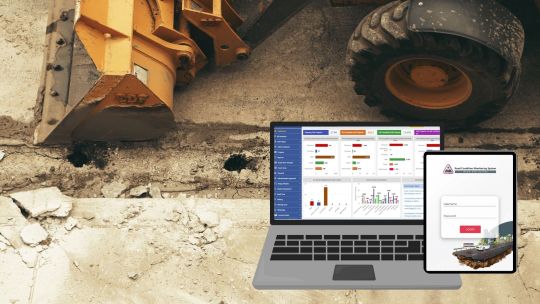
#ai and gis road monitoring solutions#geospatial road management solutions#geospatial road monitoring system#gis based pothole mapping and detection#gis based road condition monitoring system#gis based road inspection software#gis based road survey solutions#gis data analysis for road monitoring#gis mapping for road condition analysis#gis road maintenance solutions#land management system#gis tools for road condition assessment#pothole detection using gis technology#real time road condition monitoring gis#road condition assessment using gis#road condition monitoring using gis#road infrastructure monitoring with gis#road maintenance gis software#road safety monitoring with gis systems#road surface monitoring with gis#smart road condition monitoring gis
1 note
·
View note
Text
How To Create a Simple Customer Referral Program?
Counterfeit products are harmful for buyers, businesses and economies worldwide. To combat this issue barcode scanners are emerging as a powerful tool in the fight against counterfeit goods.

#dynamic qr code#qr code manufacturer#brand protection#anti-counterfeit solutions#customer loyalty programs#qr code provider#qr code provider in india#customized solution#label provider in india#anti-counterfeit solution company#anti-counterfeit technologies#anti-counterfeiting solutions in india#industrial tags manufacturer#e-warranty#data analysis#cash transfer#customer loyalty service#track & trace services#raffle#run survey#build loyalty#digital marketing#software development#digital marketing services#qr code maker#qr code generator#qr code generator with logo#qr code generator online#custom qr code generator#custom packaging for small business
0 notes
Text
5 Methods of Data Collection for Quantitative Research
Discover five powerful techniques for gathering quantitative data in research, essential for uncovering trends, patterns, and correlations. Explore proven methodologies that empower researchers to collect and analyze data effectively.
#Quantitative research methods#Data collection techniques#Survey design#Statistical analysis#Quantitative data analysis#Research methodology#Data gathering strategies#Quantitative research tools#Sampling methods#Statistical sampling#Questionnaire design#Data collection process#Quantitative data interpretation#Research survey techniques#Data analysis software#Experimental design#Descriptive statistics#Inferential statistics#Population sampling#Data validation methods#Structured interviews#Online surveys#Observation techniques#Quantitative data reliability#Research instrument design#Data visualization techniques#Statistical significance#Data coding procedures#Cross-sectional studies#Longitudinal studies
1 note
·
View note
Text

The Entertainment and Performing Arts industry witnessed notable trends in employee retention and turnover. Despite the industry's dynamic and creative nature, it faces unique challenges that impact workforce stability. High turnover rates occur, as freelancers and project-based roles represent the preponderance careers, contributing to a fluid and ever-changing labor landscape.
Factors influencing turnover in the Arts & Entertainment sector include the largest union renegotiations affecting writers and actors, the rise of Artificial Intelligence, the project-based nature of work, and the pursuit of diverse artistic opportunities. Professionals in the industry often seek creative autonomy, consistent projects, and opportunities for skill development, making employee retention a complex challenge.
Organizations will succeed to retain creative talent that prioritize inclusive and supportive work cultures, offer opportunities for professional growth and provide fair long-term compensation packages. Additionally, the rise of remote work has introduced new dynamics to talent retention, with flexibility becoming a key factor for many in the industry.
As the Arts & Entertainment industry continues to evolve, employers adapt retention strategies to address these trends, placing greater emphasis on fostering positive workplace culture, offering stability in work, and providing meaningful opportunities for career advancement. Effectively predicting staff turnover with exit interview software will be crucial for organizations looking to attract and retain top talent in this vibrant and creative field.

#Arts & Entertainment#exitpro#exit survey#exit interview#employee retention#exit interview questions#exit interview software#employee turnover#exit interviews#turnover analysis#exit interview tips
0 notes
Text
#Saudi Arabia Marine Fleet Management Software Market#Market Size#Market Share#Market Trends#Market Analysis#Industry Survey#Market Demand#Top Major Key Player#Market Estimate#Market Segments#Industry Data
0 notes
Text

In today's data-driven world, organizations are increasingly relying on surveys to gather valuable information from their customers, employees, and stakeholders. However, the true power of surveys lies not just in collecting data but in extracting meaningful insights from it. That's where survey software comes into play. In this blog post, we'll explore advanced techniques that can help you unlock hidden insights using survey analysis software.
0 notes
Text
twst overblot boys survey

Over the years, I’ve noticed trends in behaviors and attitudes between fans of particular Twst characters and I’ve wanted to know if there was any evidence to back up these observations. In other words… Are individuals with certain traits more likely to gravitate to one Twst character (in this case, one of the overblot boys) over the others? And maybe if this survey is successful, I’ll ask the same of the rest of the cast—
And so I thought to collect this data, analyze the results, and share the final report with the public. This will be done with the help of a friend (Mod Jeido from twstgameplay) that was also curious about the topic. The analysis itself will be conducted using JMP, a statistical software.
If you’re interested too, then please fill out the following form and/or share it on socials. (I don’t have a Reddit or Tiktok and I’m not active on Twitter so I’s appreciate it a lot!!) The more responses collected, the stronger the conclusions we can make!
The form will close on July 15th, so please get your responses in before then!
#Leona Kingscholar#Malleus Draconia#Azul Ashengrotto#twisted wonderland#twst#disney twisted wonderland#disney twst#twst en#twisted wonderland x reader#twst x reader#twisted wonderland en#twst survey#twisted wonderland survey#twst jp#twisted wonderland jp#notes from the writing raven#Riddle Rosehearts#Jamil Viper#Idia Shroud#Vil Schoenheit
936 notes
·
View notes
Text
AI “art” and uncanniness
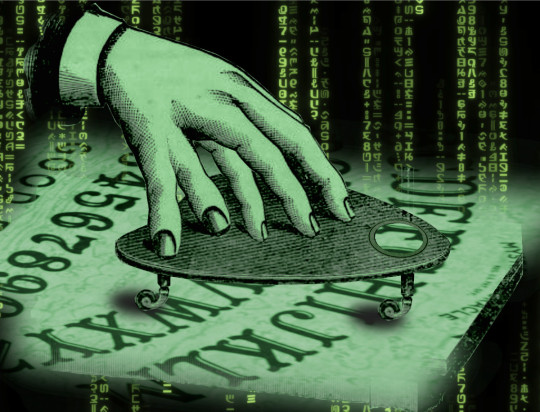
TOMORROW (May 14), I'm on a livecast about AI AND ENSHITTIFICATION with TIM O'REILLY; on TOMORROW (May 15), I'm in NORTH HOLLYWOOD for a screening of STEPHANIE KELTON'S FINDING THE MONEY; FRIDAY (May 17), I'm at the INTERNET ARCHIVE in SAN FRANCISCO to keynote the 10th anniversary of the AUTHORS ALLIANCE.

When it comes to AI art (or "art"), it's hard to find a nuanced position that respects creative workers' labor rights, free expression, copyright law's vital exceptions and limitations, and aesthetics.
I am, on balance, opposed to AI art, but there are some important caveats to that position. For starters, I think it's unequivocally wrong – as a matter of law – to say that scraping works and training a model with them infringes copyright. This isn't a moral position (I'll get to that in a second), but rather a technical one.
Break down the steps of training a model and it quickly becomes apparent why it's technically wrong to call this a copyright infringement. First, the act of making transient copies of works – even billions of works – is unequivocally fair use. Unless you think search engines and the Internet Archive shouldn't exist, then you should support scraping at scale:
https://pluralistic.net/2023/09/17/how-to-think-about-scraping/
And unless you think that Facebook should be allowed to use the law to block projects like Ad Observer, which gathers samples of paid political disinformation, then you should support scraping at scale, even when the site being scraped objects (at least sometimes):
https://pluralistic.net/2021/08/06/get-you-coming-and-going/#potemkin-research-program
After making transient copies of lots of works, the next step in AI training is to subject them to mathematical analysis. Again, this isn't a copyright violation.
Making quantitative observations about works is a longstanding, respected and important tool for criticism, analysis, archiving and new acts of creation. Measuring the steady contraction of the vocabulary in successive Agatha Christie novels turns out to offer a fascinating window into her dementia:
https://www.theguardian.com/books/2009/apr/03/agatha-christie-alzheimers-research
Programmatic analysis of scraped online speech is also critical to the burgeoning formal analyses of the language spoken by minorities, producing a vibrant account of the rigorous grammar of dialects that have long been dismissed as "slang":
https://www.researchgate.net/publication/373950278_Lexicogrammatical_Analysis_on_African-American_Vernacular_English_Spoken_by_African-Amecian_You-Tubers
Since 1988, UCL Survey of English Language has maintained its "International Corpus of English," and scholars have plumbed its depth to draw important conclusions about the wide variety of Englishes spoken around the world, especially in postcolonial English-speaking countries:
https://www.ucl.ac.uk/english-usage/projects/ice.htm
The final step in training a model is publishing the conclusions of the quantitative analysis of the temporarily copied documents as software code. Code itself is a form of expressive speech – and that expressivity is key to the fight for privacy, because the fact that code is speech limits how governments can censor software:
https://www.eff.org/deeplinks/2015/04/remembering-case-established-code-speech/
Are models infringing? Well, they certainly can be. In some cases, it's clear that models "memorized" some of the data in their training set, making the fair use, transient copy into an infringing, permanent one. That's generally considered to be the result of a programming error, and it could certainly be prevented (say, by comparing the model to the training data and removing any memorizations that appear).
Not every seeming act of memorization is a memorization, though. While specific models vary widely, the amount of data from each training item retained by the model is very small. For example, Midjourney retains about one byte of information from each image in its training data. If we're talking about a typical low-resolution web image of say, 300kb, that would be one three-hundred-thousandth (0.0000033%) of the original image.
Typically in copyright discussions, when one work contains 0.0000033% of another work, we don't even raise the question of fair use. Rather, we dismiss the use as de minimis (short for de minimis non curat lex or "The law does not concern itself with trifles"):
https://en.wikipedia.org/wiki/De_minimis
Busting someone who takes 0.0000033% of your work for copyright infringement is like swearing out a trespassing complaint against someone because the edge of their shoe touched one blade of grass on your lawn.
But some works or elements of work appear many times online. For example, the Getty Images watermark appears on millions of similar images of people standing on red carpets and runways, so a model that takes even in infinitesimal sample of each one of those works might still end up being able to produce a whole, recognizable Getty Images watermark.
The same is true for wire-service articles or other widely syndicated texts: there might be dozens or even hundreds of copies of these works in training data, resulting in the memorization of long passages from them.
This might be infringing (we're getting into some gnarly, unprecedented territory here), but again, even if it is, it wouldn't be a big hardship for model makers to post-process their models by comparing them to the training set, deleting any inadvertent memorizations. Even if the resulting model had zero memorizations, this would do nothing to alleviate the (legitimate) concerns of creative workers about the creation and use of these models.
So here's the first nuance in the AI art debate: as a technical matter, training a model isn't a copyright infringement. Creative workers who hope that they can use copyright law to prevent AI from changing the creative labor market are likely to be very disappointed in court:
https://www.hollywoodreporter.com/business/business-news/sarah-silverman-lawsuit-ai-meta-1235669403/
But copyright law isn't a fixed, eternal entity. We write new copyright laws all the time. If current copyright law doesn't prevent the creation of models, what about a future copyright law?
Well, sure, that's a possibility. The first thing to consider is the possible collateral damage of such a law. The legal space for scraping enables a wide range of scholarly, archival, organizational and critical purposes. We'd have to be very careful not to inadvertently ban, say, the scraping of a politician's campaign website, lest we enable liars to run for office and renege on their promises, while they insist that they never made those promises in the first place. We wouldn't want to abolish search engines, or stop creators from scraping their own work off sites that are going away or changing their terms of service.
Now, onto quantitative analysis: counting words and measuring pixels are not activities that you should need permission to perform, with or without a computer, even if the person whose words or pixels you're counting doesn't want you to. You should be able to look as hard as you want at the pixels in Kate Middleton's family photos, or track the rise and fall of the Oxford comma, and you shouldn't need anyone's permission to do so.
Finally, there's publishing the model. There are plenty of published mathematical analyses of large corpuses that are useful and unobjectionable. I love me a good Google n-gram:
https://books.google.com/ngrams/graph?content=fantods%2C+heebie-jeebies&year_start=1800&year_end=2019&corpus=en-2019&smoothing=3
And large language models fill all kinds of important niches, like the Human Rights Data Analysis Group's LLM-based work helping the Innocence Project New Orleans' extract data from wrongful conviction case files:
https://hrdag.org/tech-notes/large-language-models-IPNO.html
So that's nuance number two: if we decide to make a new copyright law, we'll need to be very sure that we don't accidentally crush these beneficial activities that don't undermine artistic labor markets.
This brings me to the most important point: passing a new copyright law that requires permission to train an AI won't help creative workers get paid or protect our jobs.
Getty Images pays photographers the least it can get away with. Publishers contracts have transformed by inches into miles-long, ghastly rights grabs that take everything from writers, but still shifts legal risks onto them:
https://pluralistic.net/2022/06/19/reasonable-agreement/
Publishers like the New York Times bitterly oppose their writers' unions:
https://actionnetwork.org/letters/new-york-times-stop-union-busting
These large corporations already control the copyrights to gigantic amounts of training data, and they have means, motive and opportunity to license these works for training a model in order to pay us less, and they are engaged in this activity right now:
https://www.nytimes.com/2023/12/22/technology/apple-ai-news-publishers.html
Big games studios are already acting as though there was a copyright in training data, and requiring their voice actors to begin every recording session with words to the effect of, "I hereby grant permission to train an AI with my voice" and if you don't like it, you can hit the bricks:
https://www.vice.com/en/article/5d37za/voice-actors-sign-away-rights-to-artificial-intelligence
If you're a creative worker hoping to pay your bills, it doesn't matter whether your wages are eroded by a model produced without paying your employer for the right to do so, or whether your employer got to double dip by selling your work to an AI company to train a model, and then used that model to fire you or erode your wages:
https://pluralistic.net/2023/02/09/ai-monkeys-paw/#bullied-schoolkids
Individual creative workers rarely have any bargaining leverage over the corporations that license our copyrights. That's why copyright's 40-year expansion (in duration, scope, statutory damages) has resulted in larger, more profitable entertainment companies, and lower payments – in real terms and as a share of the income generated by their work – for creative workers.
As Rebecca Giblin and I write in our book Chokepoint Capitalism, giving creative workers more rights to bargain with against giant corporations that control access to our audiences is like giving your bullied schoolkid extra lunch money – it's just a roundabout way of transferring that money to the bullies:
https://pluralistic.net/2022/08/21/what-is-chokepoint-capitalism/
There's an historical precedent for this struggle – the fight over music sampling. 40 years ago, it wasn't clear whether sampling required a copyright license, and early hip-hop artists took samples without permission, the way a horn player might drop a couple bars of a well-known song into a solo.
Many artists were rightfully furious over this. The "heritage acts" (the music industry's euphemism for "Black people") who were most sampled had been given very bad deals and had seen very little of the fortunes generated by their creative labor. Many of them were desperately poor, despite having made millions for their labels. When other musicians started making money off that work, they got mad.
In the decades that followed, the system for sampling changed, partly through court cases and partly through the commercial terms set by the Big Three labels: Sony, Warner and Universal, who control 70% of all music recordings. Today, you generally can't sample without signing up to one of the Big Three (they are reluctant to deal with indies), and that means taking their standard deal, which is very bad, and also signs away your right to control your samples.
So a musician who wants to sample has to sign the bad terms offered by a Big Three label, and then hand $500 out of their advance to one of those Big Three labels for the sample license. That $500 typically doesn't go to another artist – it goes to the label, who share it around their executives and investors. This is a system that makes every artist poorer.
But it gets worse. Putting a price on samples changes the kind of music that can be economically viable. If you wanted to clear all the samples on an album like Public Enemy's "It Takes a Nation of Millions To Hold Us Back," or the Beastie Boys' "Paul's Boutique," you'd have to sell every CD for $150, just to break even:
https://memex.craphound.com/2011/07/08/creative-license-how-the-hell-did-sampling-get-so-screwed-up-and-what-the-hell-do-we-do-about-it/
Sampling licenses don't just make every artist financially worse off, they also prevent the creation of music of the sort that millions of people enjoy. But it gets even worse. Some older, sample-heavy music can't be cleared. Most of De La Soul's catalog wasn't available for 15 years, and even though some of their seminal music came back in March 2022, the band's frontman Trugoy the Dove didn't live to see it – he died in February 2022:
https://www.vulture.com/2023/02/de-la-soul-trugoy-the-dove-dead-at-54.html
This is the third nuance: even if we can craft a model-banning copyright system that doesn't catch a lot of dolphins in its tuna net, it could still make artists poorer off.
Back when sampling started, it wasn't clear whether it would ever be considered artistically important. Early sampling was crude and experimental. Musicians who trained for years to master an instrument were dismissive of the idea that clicking a mouse was "making music." Today, most of us don't question the idea that sampling can produce meaningful art – even musicians who believe in licensing samples.
Having lived through that era, I'm prepared to believe that maybe I'll look back on AI "art" and say, "damn, I can't believe I never thought that could be real art."
But I wouldn't give odds on it.
I don't like AI art. I find it anodyne, boring. As Henry Farrell writes, it's uncanny, and not in a good way:
https://www.programmablemutter.com/p/large-language-models-are-uncanny
Farrell likens the work produced by AIs to the movement of a Ouija board's planchette, something that "seems to have a life of its own, even though its motion is a collective side-effect of the motions of the people whose fingers lightly rest on top of it." This is "spooky-action-at-a-close-up," transforming "collective inputs … into apparently quite specific outputs that are not the intended creation of any conscious mind."
Look, art is irrational in the sense that it speaks to us at some non-rational, or sub-rational level. Caring about the tribulations of imaginary people or being fascinated by pictures of things that don't exist (or that aren't even recognizable) doesn't make any sense. There's a way in which all art is like an optical illusion for our cognition, an imaginary thing that captures us the way a real thing might.
But art is amazing. Making art and experiencing art makes us feel big, numinous, irreducible emotions. Making art keeps me sane. Experiencing art is a precondition for all the joy in my life. Having spent most of my life as a working artist, I've come to the conclusion that the reason for this is that art transmits an approximation of some big, numinous irreducible emotion from an artist's mind to our own. That's it: that's why art is amazing.
AI doesn't have a mind. It doesn't have an intention. The aesthetic choices made by AI aren't choices, they're averages. As Farrell writes, "LLM art sometimes seems to communicate a message, as art does, but it is unclear where that message comes from, or what it means. If it has any meaning at all, it is a meaning that does not stem from organizing intention" (emphasis mine).
Farrell cites Mark Fisher's The Weird and the Eerie, which defines "weird" in easy to understand terms ("that which does not belong") but really grapples with "eerie."
For Fisher, eeriness is "when there is something present where there should be nothing, or is there is nothing present when there should be something." AI art produces the seeming of intention without intending anything. It appears to be an agent, but it has no agency. It's eerie.
Fisher talks about capitalism as eerie. Capital is "conjured out of nothing" but "exerts more influence than any allegedly substantial entity." The "invisible hand" shapes our lives more than any person. The invisible hand is fucking eerie. Capitalism is a system in which insubstantial non-things – corporations – appear to act with intention, often at odds with the intentions of the human beings carrying out those actions.
So will AI art ever be art? I don't know. There's a long tradition of using random or irrational or impersonal inputs as the starting point for human acts of artistic creativity. Think of divination:
https://pluralistic.net/2022/07/31/divination/
Or Brian Eno's Oblique Strategies:
http://stoney.sb.org/eno/oblique.html
I love making my little collages for this blog, though I wouldn't call them important art. Nevertheless, piecing together bits of other peoples' work can make fantastic, important work of historical note:
https://www.johnheartfield.com/John-Heartfield-Exhibition/john-heartfield-art/famous-anti-fascist-art/heartfield-posters-aiz
Even though painstakingly cutting out tiny elements from others' images can be a meditative and educational experience, I don't think that using tiny scissors or the lasso tool is what defines the "art" in collage. If you can automate some of this process, it could still be art.
Here's what I do know. Creating an individual bargainable copyright over training will not improve the material conditions of artists' lives – all it will do is change the relative shares of the value we create, shifting some of that value from tech companies that hate us and want us to starve to entertainment companies that hate us and want us to starve.
As an artist, I'm foursquare against anything that stands in the way of making art. As an artistic worker, I'm entirely committed to things that help workers get a fair share of the money their work creates, feed their families and pay their rent.
I think today's AI art is bad, and I think tomorrow's AI art will probably be bad, but even if you disagree (with either proposition), I hope you'll agree that we should be focused on making sure art is legal to make and that artists get paid for it.
Just because copyright won't fix the creative labor market, it doesn't follow that nothing will. If we're worried about labor issues, we can look to labor law to improve our conditions. That's what the Hollywood writers did, in their groundbreaking 2023 strike:
https://pluralistic.net/2023/10/01/how-the-writers-guild-sunk-ais-ship/
Now, the writers had an advantage: they are able to engage in "sectoral bargaining," where a union bargains with all the major employers at once. That's illegal in nearly every other kind of labor market. But if we're willing to entertain the possibility of getting a new copyright law passed (that won't make artists better off), why not the possibility of passing a new labor law (that will)? Sure, our bosses won't lobby alongside of us for more labor protection, the way they would for more copyright (think for a moment about what that says about who benefits from copyright versus labor law expansion).
But all workers benefit from expanded labor protection. Rather than going to Congress alongside our bosses from the studios and labels and publishers to demand more copyright, we could go to Congress alongside every kind of worker, from fast-food cashiers to publishing assistants to truck drivers to demand the right to sectoral bargaining. That's a hell of a coalition.
And if we do want to tinker with copyright to change the way training works, let's look at collective licensing, which can't be bargained away, rather than individual rights that can be confiscated at the entrance to our publisher, label or studio's offices. These collective licenses have been a huge success in protecting creative workers:
https://pluralistic.net/2023/02/26/united-we-stand/
Then there's copyright's wildest wild card: The US Copyright Office has repeatedly stated that works made by AIs aren't eligible for copyright, which is the exclusive purview of works of human authorship. This has been affirmed by courts:
https://pluralistic.net/2023/08/20/everything-made-by-an-ai-is-in-the-public-domain/
Neither AI companies nor entertainment companies will pay creative workers if they don't have to. But for any company contemplating selling an AI-generated work, the fact that it is born in the public domain presents a substantial hurdle, because anyone else is free to take that work and sell it or give it away.
Whether or not AI "art" will ever be good art isn't what our bosses are thinking about when they pay for AI licenses: rather, they are calculating that they have so much market power that they can sell whatever slop the AI makes, and pay less for the AI license than they would make for a human artist's work. As is the case in every industry, AI can't do an artist's job, but an AI salesman can convince an artist's boss to fire the creative worker and replace them with AI:
https://pluralistic.net/2024/01/29/pay-no-attention/#to-the-little-man-behind-the-curtain
They don't care if it's slop – they just care about their bottom line. A studio executive who cancels a widely anticipated film prior to its release to get a tax-credit isn't thinking about artistic integrity. They care about one thing: money. The fact that AI works can be freely copied, sold or given away may not mean much to a creative worker who actually makes their own art, but I assure you, it's the only thing that matters to our bosses.

If you'd like an essay-formatted version of this post to read or share, here's a link to it on pluralistic.net, my surveillance-free, ad-free, tracker-free blog:
https://pluralistic.net/2024/05/13/spooky-action-at-a-close-up/#invisible-hand
#pluralistic#ai art#eerie#ai#weird#henry farrell#copyright#copyfight#creative labor markets#what is art#ideomotor response#mark fisher#invisible hand#uncanniness#prompting
272 notes
·
View notes
Text
As firms increasingly rely on artificial intelligence-driven hiring platforms, many highly qualified candidates are finding themselves on the cutting room floor. Body-language analysis. Vocal assessments. Gamified tests. CV scanners. These are some of the tools companies use to screen candidates with artificial intelligence recruiting software. Job applicants face these machine prompts – and AI decides whether they are a good match or fall short. Businesses are increasingly relying on them. A late-2023 IBM survey of more than 8,500 global IT professionals showed 42% of companies were using AI screening "to improve recruiting and human resources". Another 40% of respondents were considering integrating the technology. Many leaders across the corporate world hoped AI recruiting tech would end biases in the hiring process. Yet in some cases, the opposite is happening. Some experts say these tools are inaccurately screening some of the most qualified job applicants – and concerns are growing the software may be excising the best candidates. "We haven't seen a whole lot of evidence that there's no bias here… or that the tool picks out the most qualified candidates," says Hilke Schellmann, US-based author of the Algorithm: How AI Can Hijack Your Career and Steal Your Future, and an assistant professor of journalism at New York University. She believes the biggest risk such software poses to jobs is not machines taking workers' positions, as is often feared – but rather preventing them from getting a role at all.
98 notes
·
View notes
Text
Blorbos at Conference!
Long time, no update, but this project is moving forward! This weekend, we're at a conference hosted by the Society for Cinema and Media Studies, or SCMS, presenting as part of a panel devoted to fan studies.
Why do panels matter?
First and foremost, it's a way to get research before a bunch of other researchers while it's still in progress. This helps catch poorly formed ideas, surface new good ideas, and share what's coming up with the fan studies research communities. It's also good for our humble PhD student CVs!
The Findings
Of course, the most interesting part is what, actually, we're presenting, AKA the findings! They're a work in progress, and the hardest part is the coding (talked about here). Therefore, I'm focusing on what I could do deep analysis on relatively quickly. (note: these images don't have image IDs because I summarize them below, but they're graphic representations of what I talk about in the text).
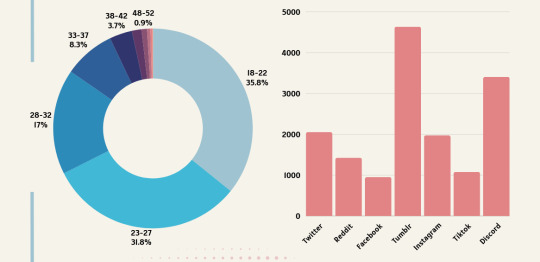
The majority of survey respondents were young: about 39% were 18-22 and 32% were 23-27. A further 17% were 28-32, about 8% were 33-37, and then it got progressively smaller from there. Shoutout to all 3 respondents who were 63 and over! So glad you're here.
In terms of social media usage, most people used tumblr - unsurprising, since that's where we got our most traction for the survey. Discord was the second most likely. Part of a later analysis will be seeing if these terms are more likely to be used by different age groups or on different platforms, which is cool.
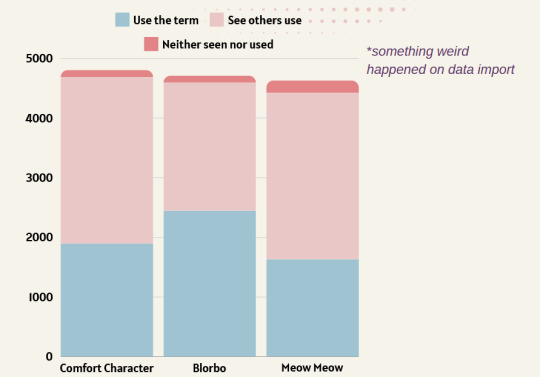
Almost everyone surveyed had heard of these terms. Blorbo was the most-used and meow meow was least used, but very, very few respondents had not heard of these terms at all. This may be in part due to how we used them in our survey recruitment, since we did want to find people who knew what these terms were so that they could define them for us.
These numbers slope slightly down because something broke when we imported them into NVivo (a coding software) and frankly I don't understand it well even when it actually works, let alone when it breaks.
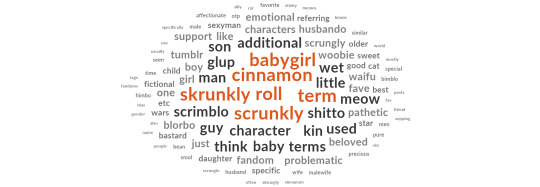
Here's a little visual of the terms you suggested for characters. Unfortunately, NVivo crashes every time I try to exclude words from this word bubble (like "term"), so it's not as clear as I'd like it to be, but there are some interesting ones. Particularly interesting are the cluster of gendered terms; husbando and waifu, malewife, sexyman, boy, girl, etc. I want to do some analysis of this because it parallels some preliminary coding results. Y'all also really find your blorbos scrunkly/skrunkly/scrungly, huh?
I also want to figure out how to tell the visualizer that "glup" and "shitto" go together, because "shitto" all by its lonesome over there is cracking me up.
Qualitative Findings
Like I said, the coding is...so far from done. That's mostly due to some Ao3-author levels of life disruption from both of us. BUT! I can tentatively say a couple of things:
There are notably clear definitions about these terms. We weren't sure if there even really was a definition of "blorbo", but it clearly refers to a very specific kind of one-true-character. By contrast, comfort characters are associated with experiencing positive emotions, and meow meows are more likely to be evil or morally grey (but you love them though).
Unsurprisingly, your characters make you happy. We're distinguishing between general positive emotions, attachment, relatability, and one-true-character belovedness. Also sexiness, but that (surprisingly) hasn't come up that much.
There are a couple of ways in which darker themes come up. Villains remain beloved, but a recurring theme is also using tragedy or trauma in fiction as catharsis.
Finally, there's a lot of playful and tactile language. "Rotating him in my mind" really is that common.
Additionally, I'm really interested in the role of gender. Many of you referred to your blorbos/meow meows as your guys, with some of you clarifying that it was "my little guy (gender neutral)". Others noted that most characters you'd seen people describe as blorbos or meow meows were men/masc. This did not come up for comfort characters. Analysis of the characters you consider exemplars of each definition will help flesh out this analysis.
Still to Come
SO much. Who are these characters? Is a specific character exclusively a meow meow, or are they also a common comfort character? What types of positive emotion are associated with each type? Are these character types or do they speak to a fan's individual (or a fandom's communal) relationship with a character?
Additionally - we didn't ask about neurodivergence, but many of y'all referenced it. I'm looking forward to exploring that as well.
That's all for now! I present this live in about two hours. If you're somehow following this account AND at SCMS, please come by!
33 notes
·
View notes
Text
Why Need Build Customer Loyalty? A Comprehensive Guide
VCQRU is a leading anti-counterfeiting solutions company in India, offering one-stop solutions for anti-counterfeiting, custom QR code, smart packaging, labels stickers, and e-warranty solutions with dynamic QR code.
Read more:
#dynamic qr code#qr code manufacturer#brand protection#anti-counterfeit solutions#customer loyalty programs#qr code provider#qr code provider in india#customized solution#label provider in india#anti-counterfeit solution company#anti-counterfeit technologies#anti-counterfeiting solutions in india#industrial tags manufacturer#e-warranty#data analysis#cash transfer#customer loyalty service#track & trace services#raffle#run survey#build loyalty#digital marketing#software development#digital marketing services#qr code maker#qr code generator#qr code generator with logo#qr code generator online#custom qr code generator#custom packaging for small business
0 notes
Text
Excerpt from this article from the Center for Biological Diversity:
The Trump administration’s plan to sell federal public land for sprawl development could bulldoze endangered species habitat, canyons and forests across the West — from protected red cliffs in Utah to national monuments in New Mexico — according to a new map analysis from the Center for Biological Diversity.
Nearly 500 separate areas deemed worthy of protection by the Bureau of Land Management or Congress, including dozens of national monuments and protected waterways, fall within the Interior Department’s target to sell roughly 400,000 acres to local governments and private developers.
These areas include critical habitat for federally protected threatened or endangered plants and animals, including desert tortoises, Canadian lynx, Pacific martens and several species of birds and fish.
“Trump’s ham-fisted plan could destroy some of America’s most treasured places and imperiled wildlife habitat so fat cat developers can build malls, McMansions and data centers,” said Randi Spivak, public lands policy director at the Center. “It’s appalling that the Trump administration wants to steal these public lands from the public, and even more galling that these billionaires think people will stand for it. No one voted to have their favorite campsite paved over and rare animals driven to extinction.”
The Interior Department is considering selling federal lands within 10 miles of cities and towns with a population greater than 5,000 people. That would sweep in dozens of wilderness areas and areas of critical environmental concern — designated by the BLM as needing protection under federal law — in Colorado, Arizona, New Mexico, California, Nevada, Utah, Oregon, Washington, Wyoming and Montana. National monuments, including Vermilion Cliffs in Arizona, Sand to Snow in California, and Bears Ears in Utah, are also at risk, according to the Center’s analysis.
The Center’s analysis includes BLM lands designated specifically for conservation purposes, critical habitat designated for numerous threatened and endangered species, protected wild and scenic rivers, and habitat for imperiled species such as greater sage grouse. The analysis was done using mapping software and publicly available datasets from the BLM, U.S. Fish and Wildlife Service and the U.S. Geological Survey.
“We refuse to allow the reckless looting of our public lands by the Trump administration and his rich friends,” said Spivak. “We’ll do everything possible to keep Trump from paving over treasured places and wildlife habitat for sprawl development. Americans cherish their public lands and they know that once these lands are sold there’s no going back.”
Here's part of a map prepared by the Center that shows the threatened public lands. You can see the entire map (interactive) through this link.
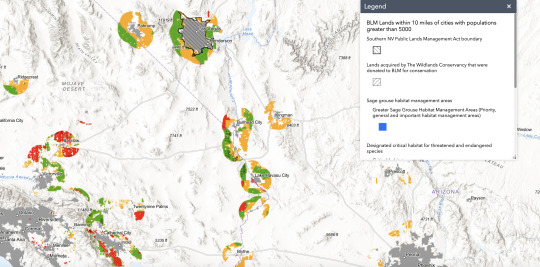
3 notes
·
View notes
Text

NASA's ready-to-use dataset details land motion across North America
NASA is collaborating with the Alaska Satellite Facility in Fairbanks to create a powerful, web-based tool that will show the movement of land across North America down to less than an inch. The online portal and its underlying dataset unlock a trove of satellite radar measurements that can help anyone identify where and by how much the land beneath their feet may be moving—whether from earthquakes, volcanoes, landslides, or the extraction of underground natural resources such as groundwater.
Spearheaded by NASA's Observational Products for End-Users from Remote Sensing Analysis (OPERA) project at the agency's Jet Propulsion Laboratory in Southern California, the effort equips users with information that would otherwise take years of training to produce. The project builds on measurements from spaceborne synthetic aperture radars, or SARs, to generate high-resolution data on how Earth's surface is moving.
For example, water-management bureaus and state geological surveys will be able to directly use the OPERA products without needing to make big investments in data storage, software engineering expertise, and computing muscle.
How it works
To create the displacement product, the OPERA team continuously draws data from the ESA (European Space Agency) Sentinel-1 radar satellites, the first of which launched in 2014. Data from NISAR, the NASA-ISRO (Indian Space Research Organization) SAR mission, will be added to the mix after that spacecraft launches later this year.
Satellite-borne radars work by emitting microwave pulses at Earth's surface. The signals scatter when they hit land and water surfaces, buildings, and other objects. Raw data consists of the strength and time delay of the signals that echo back to the sensor.
To understand how land in a given area is moving, OPERA algorithms automate steps in an otherwise painstaking process. Without OPERA, a researcher would first download hundreds or thousands of data files, each representing a pass of the radar over the point of interest, then make sure the data aligned geographically over time and had precise coordinates.
Then they would use a computationally intensive technique called radar interferometry to gauge how much the land moved, if at all, and in which direction—towards the satellite, which would indicate the land rose, or away from the satellite, which would mean it sank.
"The OPERA project has helped bring that capability to the masses, making it more accessible to state and federal agencies, and also users wondering, 'What's going on around my house?'" said Franz Meyer, chief scientist of the Alaska Satellite Facility, a part of the University of Alaska Fairbanks Geophysical Institute.
Monitoring groundwater
Sinking land is a top priority to the Arizona Department of Water Resources. From the 1950s through the 1980s, it was the main form of ground movement officials saw, as groundwater pumping increased alongside growth in the state's population and agricultural industry. In 1980, the state enacted the Groundwater Management Act, which reduced its reliance on groundwater in highly populated areas and included requirements to monitor its use.
The department began to measure this sinking, called subsidence, with radar data from various satellites in the early 2000s, using a combination of SAR, GPS-based monitoring, and traditional surveying to inform groundwater-management decisions.
Now, the OPERA dataset and portal will help the agency share subsidence information with officials and community members, said Brian Conway, the department's principal hydrogeologist and supervisor of its geophysics unit. They won't replace the SAR analysis he performs, but they will offer points of comparison for his calculations. Because the dataset and portal will cover the entire state, they also could identify areas not yet known to be subsiding.
"It's a great tool to say, "Let's look at those areas more intensely with our own SAR processing,'" Conway said.
The displacement product is part of a series of data products OPERA has released since 2023. The project began in 2020 with a multidisciplinary team of scientists at JPL working to address satellite data needs across different federal agencies. Through the Satellite Needs Working Group, those agencies submitted their requests, and the OPERA team worked to improve access to information to aid a range of efforts such as disaster response, deforestation tracking and wildfire monitoring.
TOP IMAGE: A new online portal by NASA and the Alaska Satellite Facility maps satellite radar measurements across North America, enabling users to track land movement since 2016 caused by earthquakes, landslides, volcanoes, and other phenomena. Credit: USGS
LOWER IMAGE: The OPERA portal shows how land is sinking in Freshkills Park, which is being built on the site of a former landfill on Staten Island, New York. Landfills tend to sink over time as waste decomposes and settles. The blue dot marks the spot where the portal is showing movement in the graph. Credit: NASA

2 notes
·
View notes